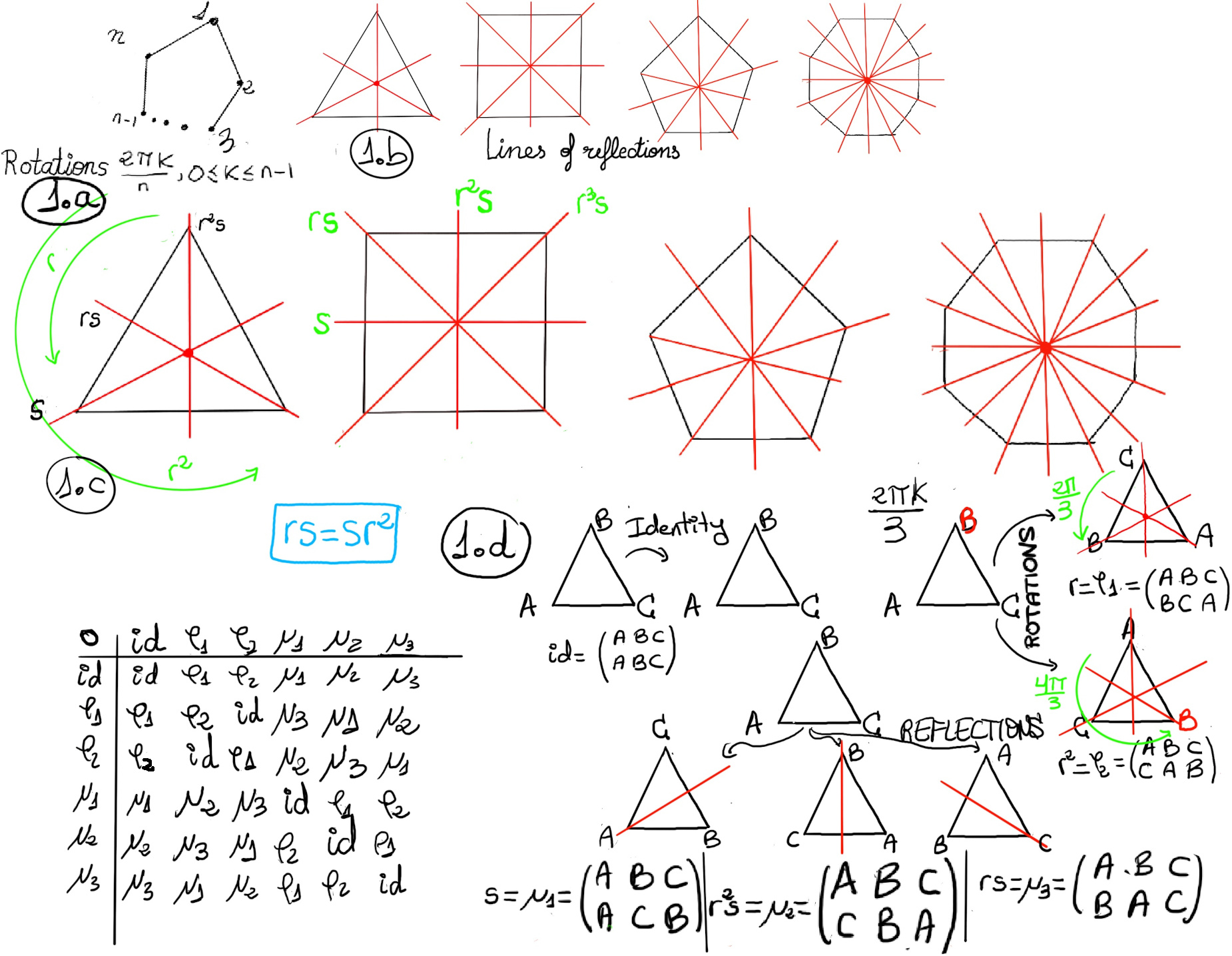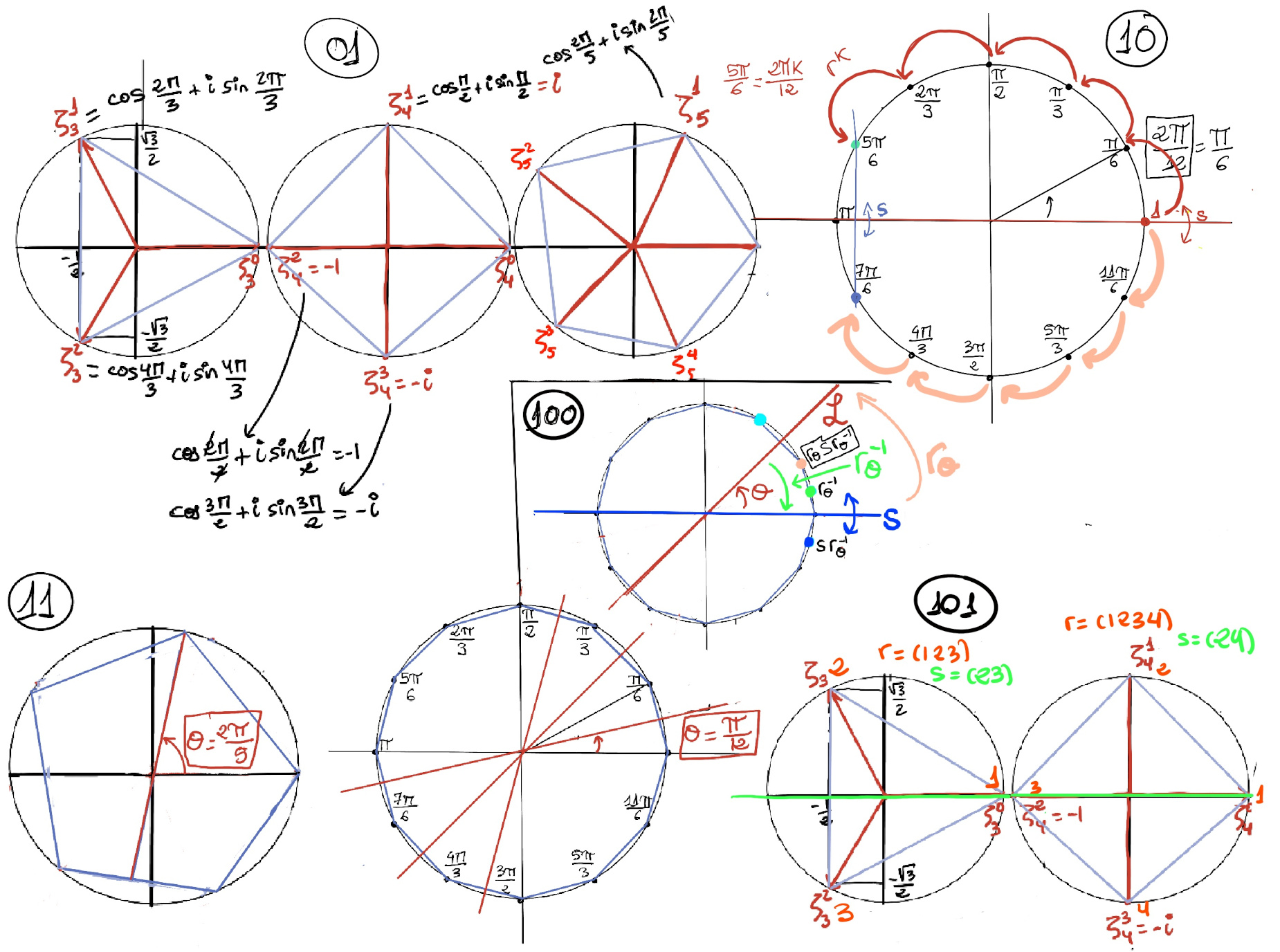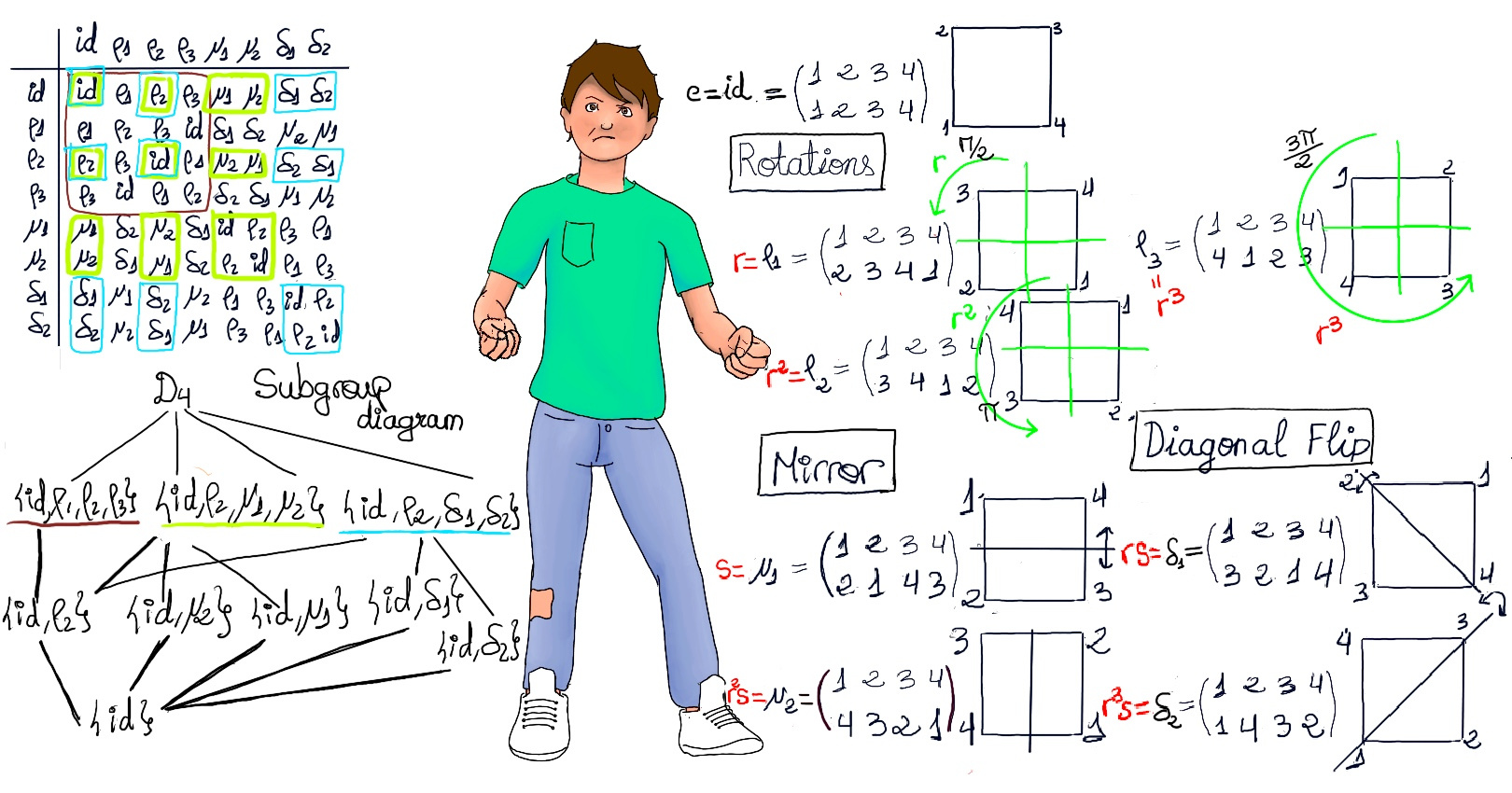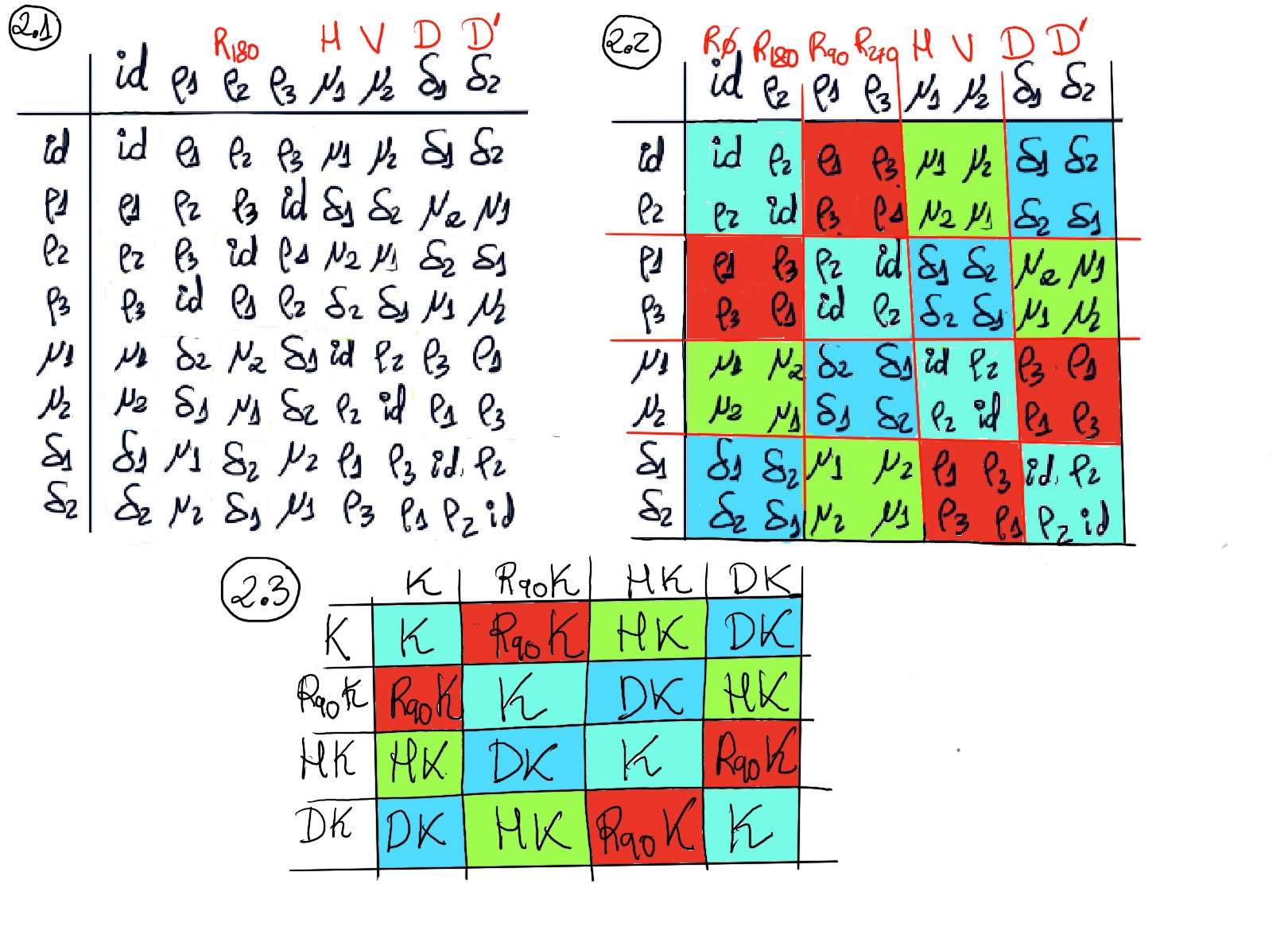
|
 |
 |
|
 |
Do you still remember that I am still only fourteen?” I said, starting to lose my temper and grasping how Mum should feel like when Dad says things like, “Such a sophisticated perfume honey, how many litres and for how long did you need to soak in it? Come to my localhost, I will turn off my firewall, disable my antivirus, grant you sudo access, and show you my source code,” Apocalypse, Anawim, #justothepoint
A polygon is a two-dimensional or plane figure that has a finite number of sides. It is described by a finite number of straight line segments connected to form a closed polygonal chain. A regular polygon is a polygon that is both equiangular (all angles are equal in measure) and equilateral (all sides have the same length).
The dihedral group Dn is the group of symmetries of a regular polygon with n vertices, which includes rotations and reflections or, in other words, the right motions taking a regular n-gon back to itself, or the arrangement of the figure preserving sides, vertices, distances, and angles.
A regular polygon can be rotated around its center in n different ways to come back to itself. More specifically, we can rotate it around the center by
$\frac{2kπ}{n}$ radians where 0 ≤ k ≤ n − 1 (Figure 1.a).

Any regular n-gon can be inscribed into a circle whose center coincides with the center of the n-gon. As the side lengths of the polygon are irrelevant in terms of symmetry, we could assume that our polygon is inscribed in the unit circle.
Let be r the counterclockwise rotation by θ = 2π⁄n, then the n rotations in Dn are e, r, r2,…, rn-1, namely, 1, e2π/n, e2(2π/n), e3(2π/n),···, e(n-1)(2π/n), Figure 01.

Theorem. Let s be a reflection across the real axis. Let Dn be the dihedral group. Then, srks-1 = r-k. In particular, srk = r-ks (by multiplying the previous equation by s).
Proof.
Consider srks-1 = [s2 = 1 ⇒ s = s-1] srks = [srks means to reflect across the x-axis, then rotate by θ = 2πk⁄n counterclockwise, that is, k rotations by r = 2π⁄n counterclockwise, and finally reflect across the x-axis back, but this is just a rotation by θ but clockwise, that is, k rotations by r-1 clockwise, Figure 10. It is illustrated with P(1, 0)] (r-1)k = r-k ∎

Theorem. Dn is generated by the symmetries r and s, Dn = ⟨r, s⟩. In particular, every symmetry σ can be expressed in the form σ = rksl for k, l ∈ ℤ.
Proof.
We already know that the only symmetries of the unit circle are rotations and reflections. These are the only types of symmetries for the regular n-gon which is a subset of the unit circle.

Let rθ be the rotation counterclockwise by θ. ρ = $r_θsr_θ^{-1}$ (Figure 100, rθ-1 is the rotation clockwise by θ) = [By the previous lemma, srks-1 = r-k, srk = r-ks, and sr-k = s2rks-1 = rks-1 = rks, the angle θ that L makes with the positive real axis equals $k\frac{π}{n}$ for some k] rθrθs = r2θs = [2θ = 2kπ/n, r is the rotation of 2π/n counterclockwise] rks ⇒ Every symmetry of our n-gon is generated by both r and s.

Each product of r’s and s’s is called a word, and we can simplify words by collapsing down adjacent r’s and s’s together, and we can consider that we don’t need inverses since s2=1 (s = s-1) and srk = r-ks. Therefore, a generic word in Dn has the following form, $σ=r^{k_0}sr^{k_1}sr^{k_2}···sr^{k_m}$ (k0 and km could be zero, that is, a generic word can start and/or end with a rotation or a reflection).
Claim: σ = rksl for k, l ∈ ℤ.
Let’s induct on the number of s’s in σ.
Case base. The number of s’s is 0 ⇒ σ = rk0 = rk0s0.
Suppose that if σ involves m-1 s’s, then σ = rksl for some k, l ∈ ℤ.
$σ=r^{k_0}sr^{k_1}sr^{k_2}···sr^{k_m}=(r^{k_0}sr^{k_1}sr^{k_2}···sr^{k_{m-1}})sr^{k_m}$ = [By our induction hypothesis] $(r^ks^l)sr^{k_m}=r^ks^{l+1}r^{k_m}$ =
Notice: s···l+1 times···sr···km times···r = … [By the previous lema, srk=r-ks each of the km r’s can be flipped by an s and needs to be moved l+1 times] = s···l times lefts to go···(r-1s)·r···km-1 times···r = r(-1)l+1s···l+1 times···sr···km-1 times···r
= $r^kr^{(-1)^{l+1}}··_{k_m}··r^{(-1)^{l+1}}s^{l+1} = r^kr^{(-1)^{l+1}k_m}s^{l+1}$ ∎
Lemma. Every symmetry σ can be expressed in the form σ = rksl for k, l ∈ ℤ. It is called the normal form of σ and is unique up to modulo n on k and modulo 2 on l.
Proof.
Let’s suppose by reduction to the absurd that σ = rksl = rk’sl’ ⇒ r-k’rk = sl’s-l, the product of rotations is itself a rotation, and the product of reflections is also a reflection, that’s impossible, therefore the only option left is the identity.
r-k’rk = sl’s-l ⇒ r-k’rk = sl’s-l = id ⇒ rk = rk’ and sl’ = sl ⇒ k ≡ k’ (mod n) and l ≡ l’ (mod 2) since s2 = rn = e∎
Theorem. The size of Dn is 2n.
Proof.
We have already demonstrated in the previous lemma that ∀σ ∈ Dn, σ = rksl and this expression is unique up to modulo n on k and module 2 on l since s2 = rn = e, so the options are 0 ≤ k ≤ n-1 and 0 ≤ l ≤ 2 ⇒ |Dn| = 2n ∎
Theorem. Let s be reflection across a line through a vertex. The n reflections in Dn are s, rs, r2s,..., rn-1s. Figure 1.b and 1.c.
Proof. The rigid motions s, rs, r2s,…, rn-1s are different since e, r, r2,…, rn-1 are different. Futhermore, s is not a rotation. Then, we claim that rks is not a rotation either.
Suppose for the sake of contradiction, rks is a rotation ⇒ rks = rl ⇒ s = rl-k, but s is not a rotation, but a reflection ⊥ (contradiction).
Therefore, Dn = {e, r, r2,…, rn-1, s, rs, r2s,…, rn-1s}
A reflection has order 2, so s2 = 1 and s-1 = s. The elements of Dn are rotations or reflections and the product of a rotation and a reflection is always a reflection. The geometric interpretation of s, rs, r2s,…, rn-1s is as follows: starting from a vertex fixed by s, we draw all lines of reflections for a regular n-gon by moving clockwise $\frac{2kπ}{n}$ radians where 0 ≤ k ≤ n − 1.
The rigid motions r and s do not commute, but srn-1 = rs, and therefore Dn = {e, r, r2,…, rn-1, s, rs, r2s,…, rn-1s} = ⟨r, s | rn = s2 = e, rs = srn-1⟩.
A reflection is a transformation that acts like a mirror. A line that reflects a figure onto itself is called a line of symmetry.
Exercise. Let n = 6. Compute rsr4sr3 = [∴ Associativity] (rs)r4sr3 = [∴ n=6, rs=srn-1=sr5] sr5r4sr3 = sr9sr3 = [∴ r9 = r3, 9 ≡6 3] sr3sr3 = (sr3)2 = [A rotation compose with a reflection is always a reflection and a reflection compose with itself is the identity] e.
Theorem. rks = srn-k, 1 ≤ k ≤ n-1.
Proof. Induction. Base case (k = 1) is already based on the definition of the dihedral group, Dn = ⟨r, s | rn = s2 = e, rs = srn-1⟩.
Let’s assume that the hypothesis holds for k.
rk+1s = r (rks) = [k induction hypothesis] r(srn-k) = [Associativity] (rs)rn-k = srn-1rn-k = srn+n-(k+1) = [rn = e] srn-(k+1) ∎
D3 is the symmetry group of the equilateral triangle. An equilateral triangle is a triangle in which all three sides are the same length, that is, a regular polygon with three equal sides with angles of the same measure (60°).
D3 = {id (e), rotations (ρ1 -120° around the center anticlockwise-, ρ2 -240°-), reflections or mirror images on all its vertices (μ1, μ2, and μ3)} = {e, r, r2, s, rs, r2s} = ⟨r, s | r3 = s2 = e, rs = sr2⟩.

D3 is not Abelian, e.g., ρ1μ1 = (123)(23) = (12) = μ3 ≠ μ1ρ1 = (23)(123) = (13) = μ2

A square is a regular quadrilateral (four-sided polygon), which means that it has four equal sides and four equal right angles (90° angles, π/2 radian angles). The dihedral group D4 is the symmetry group of the square.
D4 = {id (e), rotations (ρ1 -90° around the center anticlockwise-, ρ2 -180°-, and ρ3 -270°-), reflections or mirror images in the x -horizontal- and y -diagonal- axes (μ1, μ2), and reflections in the diagonals δ1 and δ2 respectively} = {e, r, r2, r3, s, rs, r2s, r3s} = ⟨r, s | r4 = s2 = e, rs = sr3⟩.

D4 is not Abelian, e.g. μ1ρ1 = (12)(34)(1234) = (24) = δ2 ≠ ρ1μ1 = (1234)(12)(34) = (13) = δ1.
$K$ = {R0, R180} = ⟨R180⟩. Let $K$ be the subgroup of D4 generated by R180, this subgroup is normal, $K$ ◁ D4.
$D_4/K$ = {$K, R_{90}K, HK, DK$} where $K$ = {R0, R180}, $R_{90}K$ = {R90, R270}, $HK$ = {HR0, HR180} = {H, V}, $DK$ = {DR0, DR180} = {D, D’}.
Its multiplication table is given in Table 2.3. Observe that the multiplication table for D4 can be simplified into small boxes that are cosets of $K$. We can represent an entire box by a single element of the box!


Definition. The center of a group, G, is the set of elements that commute with all the elements of G. Z(G) = {g ∈ G | gx = xg, ∀x ∈ G}.
Center of Dn ℤ(Dn) = $ \begin{cases} e, n~is~ odd\\\\ e~ and~ α^{\frac{n}{2}}, n~is~ even \end{cases}$
The dihedral group Dn is the group of symmetries of a regular polygon with n vertices, which includes rotations and reflections or, alternatively, the rigid motions taking a regular n-gon back to itself. Dn = {e, r, r2,…, rn-1, s, rs, r2s,…, rn-1s} = ⟨r, s | rn = s2 = e, rs = srn-1⟩.